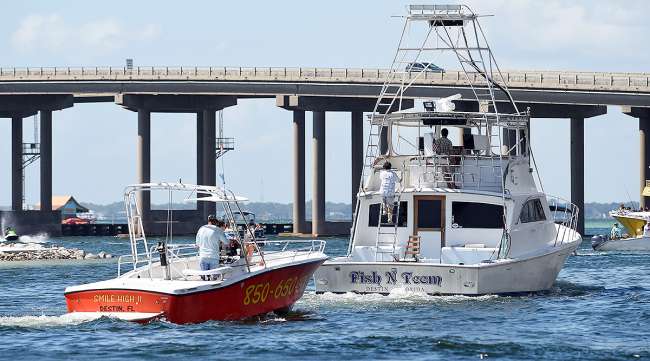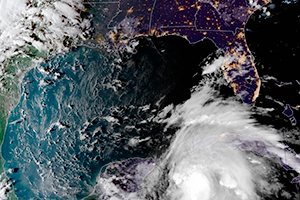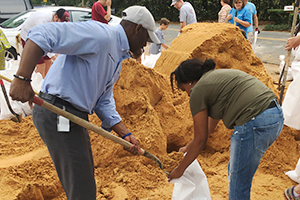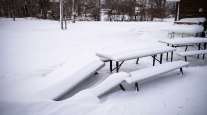Gulf Coast Braces for ‘Monstrous’ Hurricane Michael

MIAMI — Residents of Florida’s Panhandle frantically filled sandbags, boarded up homes and secured boats Oct. 8 as they anxiously awaited Hurricane Michael, which forecasters warned could smash into the state’s Gulf Coast as a dangerous major hurricane within days.
Fueled by warm tropical waters, Michael gained new strength by nightfall and could reach major hurricane status with winds topping 111 mph before its anticipated landfall Oct. 10 on the Panhandle or Big Bend area of Florida, forecasters warn.
Florida Gov. Rick Scott called Michael a “monstrous hurricane” with a devastating potential from high winds, storm surge and heavy rains.

Tropical Storm Michael churning as it heads toward the Florida Panhandle. (Associated Press)
Scott declared a state of emergency for 35 Florida counties from the Panhandle to Tampa Bay, activated hundreds of Florida National Guard members and waived tolls to encourage those near the coast to evacuate inland. Scott also said Oct. 8 that state health officials are reaching out to hospitals and nursing homes to be prepared. After Hurricane Irma last year, 14 people died when a South Florida nursing home lost power and air conditioning.
Of the elderly and infirm patients, Scott had a blunt message for their caregivers: “If you’re responsible for a patient, you’re responsible for the patient. Take care of them.”
In the small Panhandle city of Apalachicola, Mayor Van Johnson Sr. said the 2,300 residents are frantically preparing for a major hurricane strike that could be unlike any there in decades.
“We’re looking at a significant storm with significant impact, possibly greater than I’ve seen in my 59 years of life,” Johnson said of the city, straddling the shore of Apalachicola Bay, a Gulf of Mexico inlet that reaps about 90% of Florida’s oysters.
By the evening of Oct. 8, lines had formed at gas stations and grocery stories as people sought emergency supplies even as evacuations were expected to intensify in coming hours. Mandatory evacuation orders were issued for residents of barrier islands, mobile homes and low-lying coastal areas in Gulf, Wakulla and Bay counties.
In a Facebook post Oct. 8 the Wakulla County Sheriff’s Office said no shelters would be open because Wakulla County shelters were rated safe only for hurricanes with top sustained winds below 111 mph. With Michael’s winds projected to be even stronger than that, Wakulla County residents were urged to evacuate inland.
“This storm has the potential to be a historic storm, please take heed,” the sheriff’s office said in the post.
High winds weren’t the only danger. Parts of Florida’s curvy Big Bend could see up to 12 feet of storm surge, while Michael also could dump up to a foot of rain over some Panhandle communities as it moves inland, forecasters said.
Even neighbors in Alabama were bracing. Alabama Gov. Kay Ivey signed an emergency declaration for her entire state, expecting widespread power outages and other problems from Michael.
By 11 p.m. on Oct. 8, Michael’s top sustained winds had risen some to 90 mph as it headed north at 12 mph. The storm was centered about 450 miles south of Apalachicola. Hurricane-force winds extended outward up to 35 miles from the core and tropical-storm-force winds out 175 miles.
Michael was lashing western Cuba on Oct. 8 with heavy rains and strong winds. Forecasters warned that the storm could produce up to a foot of rain in western Cuba, potentially triggering flash floods and mudslides in mountainous areas.
Since the storm will spend two to three days over the Gulf of Mexico, which has warm water and favorable atmospheric conditions, “there is a real possibility that Michael will strengthen to a major hurricane before landfall,” Robbie Berg, a hurricane specialist at the Miami-based storm forecasting hub, wrote in an advisory.
A large mound of sand in Tallahassee was whittled down to a small pile within hours Oct. 8 as residents filled sandbags against potential flooding. A couple breweries in the city offered free filtered water to anyone bringing in jugs or other containers.

Tallahassee Mayor and Democratic gubernatorial candidate, Andrew Gillum, left, helps Eboni Sipling fill up sandbags in Tallahassee, Fla., Oct. 8. (Gary Fineout/Associated Press)
Tallahassee Mayor Andrew Gillum, Florida’s Democratic nominee for governor, had planned to campaign in South Florida on Oct. 8-9 but instead threw himself into helping his city’s residents fill sandbags and make other preparations.
“Today it is about life and safety,” Gillum said. “There’s nothing between us and this storm but warm water, and I think that’s what terrifies us about the potential impacts.”
Some feared significant tree damage and power outages in Florida’s capital city.
Two years ago, Hurricane Hermine knocked out power for days in Tallahassee and caused widespread flooding as it came up through the Gulf Coast.
Ann Beaver was among the many city residents who lost power that time — and braced for a similar experience to come. “I don’t want to lose everything in the freezer, but it is what is,” said Beaver as she loaded sandbags into her family’s pickup truck.
Farther west along Florida’s Panhandle, the city of Pensacola tweeted to residents, “Be sure you have your emergency plan in place.”
On the Panhandle, Escambia County Sheriff David Morgan warned residents Oct. 8 during an evening news conference evening that if they stay, first responders won’t be able to reach them during the storm or immediately after.
“If you decide to stay in your home and a tree falls on your house or the storm surge catches you and you’re now calling for help, there’s no one that can respond to help you,” Morgan said.




